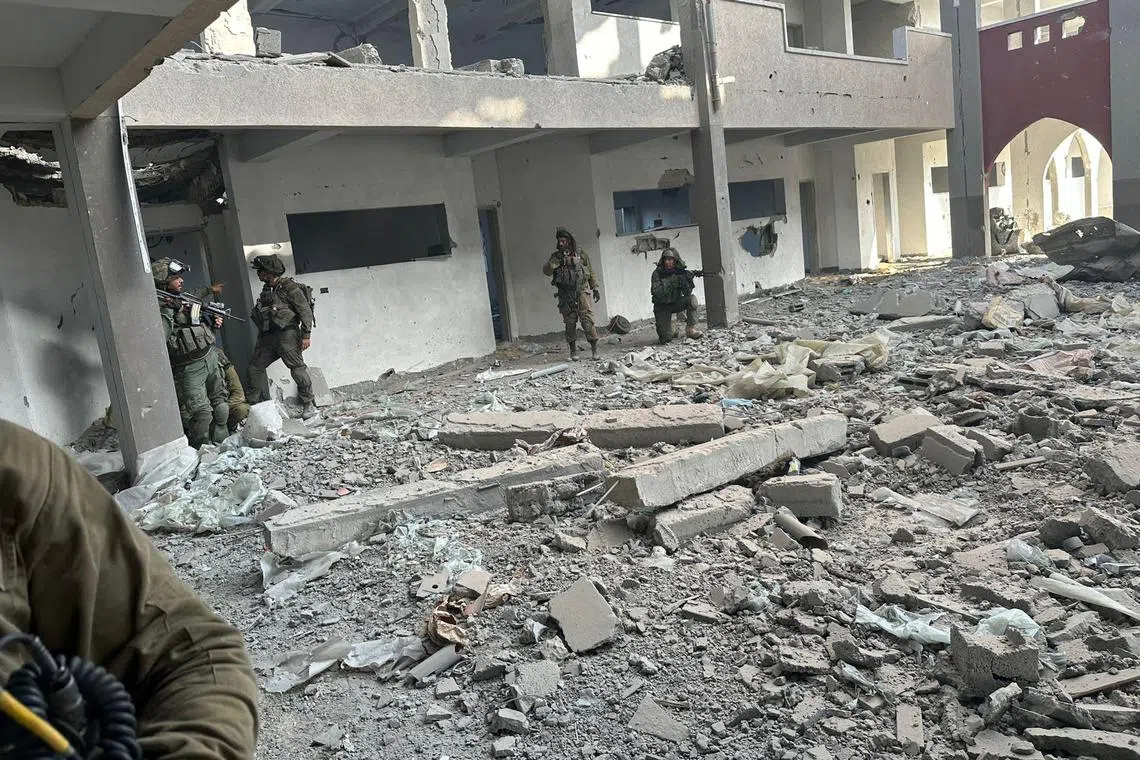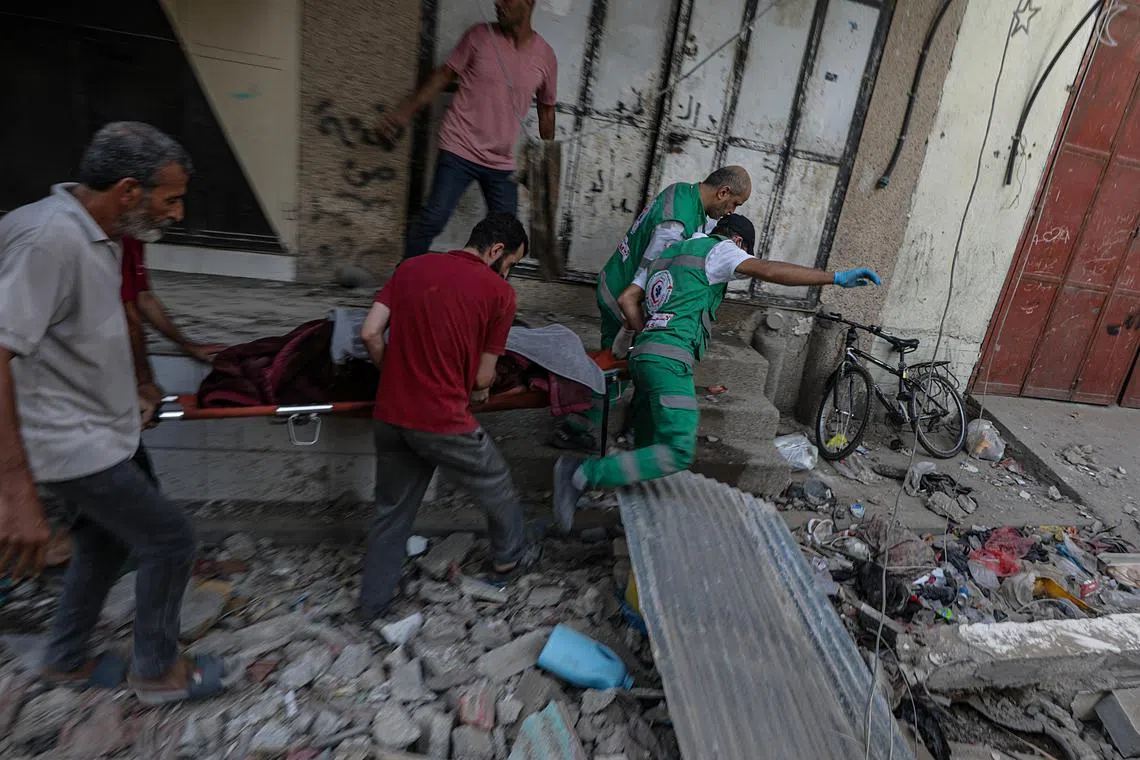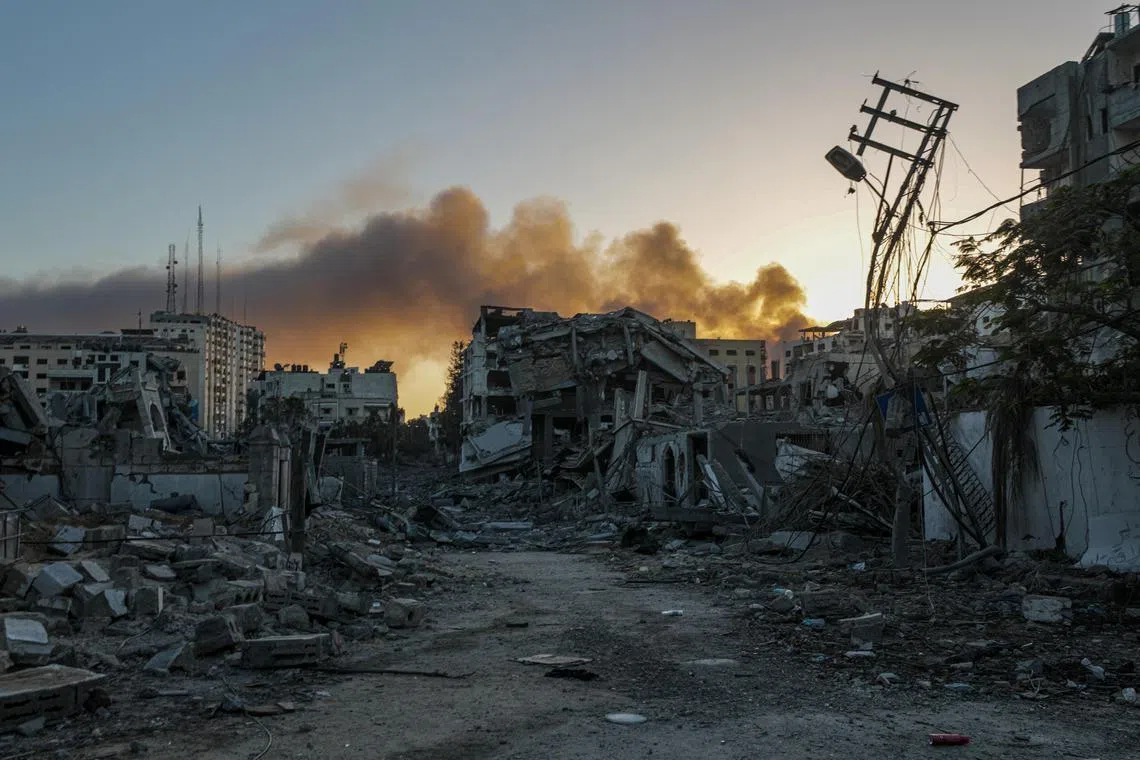Thousands of civilians flee north Gaza as Israeli troops and Hamas fighters clash
Sign up now: Get ST's newsletters delivered to your inbox
Follow topic:
GAZA/JERUSALEM - Thousands of Palestinian civilians trudged in a forlorn procession out of the north of the Gaza Strip on Wednesday seeking refuge from Israeli air strikes and fierce ground fighting between Israeli troops and Hamas militants.
The exodus took place in a four-hour window of opportunity announced by Israel, which told residents to evacuate the area or risk being trapped in the violence.
However, the central and southern parts of the small, besieged Palestinian enclave were also under fire as the war between its Islamist Hamas rulers and Israel entered its second month.
Palestinian health officials said an air strike that hit houses in Nuseirat refugee camp killed 18 people on Wednesday morning. In Khan Younis, six people, including a young girl, were killed in an air strike.
“We were sitting in peace when all of a sudden, an F-16 air strike landed on a house and blew it up, the entire block, three houses next to each other,” said a witness, Mr Mohammed Abu Daqa.
“Civilians, all of them civilians. An old woman, an old man, and there are others still missing under the rubble.”
The Israeli military said its offensive was targeting Hamas’ tunnel network beneath the enclave. Air strikes had killed a Hamas weapons maker and several fighters, it said.
Gaza City, the Hamas militant group’s main stronghold in the territory, is encircled by Israeli forces. The military said troops have advanced into the heart of the densely populated city, while Hamas says its fighters have inflicted heavy losses.
United Nations officials and Group of Seven nations stepped up appeals for a humanitarian pause in the hostilities to help alleviate the suffering of civilians in Gaza, where buildings have been flattened and basic supplies are running out.
Palestinian officials said 10,569 people have now been killed, 40 per cent of them children. The level of death and suffering is “hard to fathom”, UN health agency spokesman Christian Lindmeier said in Geneva.
Israel struck at Gaza in response to a cross-border Hamas raid on southern Israel on Oct 7 in which gunmen killed 1,400 people, mostly civilians, and took about 240 hostages, according to Israeli tallies. The war has descended into the bloodiest episode in the generations-long Israel-Palestinian conflict.
Fleeing the bombs
Thousands of Palestinians fleeing from the north wearily made their way in a long line past wrecked and bomb-scarred buildings, witnesses said.
The Israeli military had told them they should move south of the Wadi Gaza wetlands along the main Salah al-Din Road.
It was not clear exactly where they would end up, given the huge numbers of displaced people from among Gaza’s 2.3 million population that are already crammed into schools, hospitals and other sites in the south.

Defence Minister Yoav Gallant said Israeli soldiers were operating in the heart of Gaza City.
PHOTO: AFP
Thousands of others remain inside the encircled north, including at Gaza City’s main Al Shifa hospital, where Ms Um Haitham Hejela was sheltering with her young children in an improvised tent. “The situation is getting worse day after day,” she said. “There is no food, no water. When my son goes to pick up water, he queues for three or four hours in the line. They struck bakeries, we don’t have bread.”
Israel’s stated intention is to wipe out Hamas, pounding Gaza from air, land and sea, while ground troops have moved in to divide the narrow coastal strip in two in fierce urban fighting amid the ruins of buildings.
The Israeli military said on Wednesday two separate strikes eliminated a leading Hamas armourer Mahsein Abu Zina, and fighters engaged in anti-tank or ground-to-ground rocket fire.
Palestinian media reported clashes between militants and Israeli forces near Al-Shati (Beach) refugee camp in Gaza City.
Hamas’ armed wing, the Izz ad-Din al-Qassam Brigades, said its fighters had destroyed an Israeli tank in Gaza City.
There was no further word from Israel on the possible fate of the most senior Hamas leader in Gaza, Yahya Sinwar, believed to be a key planner of the Oct 7 attacks.
Israel said on Tuesday he had been cornered in his bunker.
Chief military spokesman Rear-Admiral Daniel Hagari said combat engineers were using explosive devices to destroy a Hamas tunnel network.
Hamas, which has controlled the coastal enclave since 2007, has built a tunnel city stretching beneath Gaza for hundreds of kilometres, up to 80 metres deep in parts. One hostage held in the network before being freed by Hamas last month described it as “a spider’s web”.
Israeli tanks have met heavy resistance from Hamas fighters using the tunnels to stage ambushes, according to sources with Hamas and the separate Islamic Jihad militant group. Israel says 33 of its soldiers have been killed.
Mr Avi Melamed, a former Israeli intelligence official and a negotiator during the first and second intifadas that took place in the late 1980s and early 2000s, said Israel Defence Forces troops were working through a structured plan to locate tunnels, destroy rocket launching sites, and kill Hamas commanders and fighters.
“It’s about eliminating the military spine,” he said.

A body is removed following Israeli air strikes in the Al Zaitun neighbourhood of Gaza City.
PHOTO: EPA-EFE
‘No food, no water’
The UN says Gaza’s health system is close to collapse, battered by air strikes, flooded with patients, and running out of medicine and fuel.
G-7 foreign ministers, meeting in Tokyo, called for a humanitarian pause in the fighting.
A G-7 statement said Israel had the right to defend itself, but civilians must be protected and international humanitarian law followed. A two-state solution “remains the only path to a just, lasting and secure peace”, it said.
Such a solution, envisaging the creation of an independent country for Palestinians in territory Israel captured in the 1967 Middle East war, has long been the aim of international peace efforts, but the process has been moribund since 2014.
Fears for hostages
Israelis have voiced fear that military operations could further endanger the hostages taken on Oct 7 and believed to be held in the tunnels. Israel says it will not agree to a ceasefire until the hostages are released. Hamas says it will not stop fighting while Gaza is under attack.
Washington has backed Israel’s position that a ceasefire would help Hamas militarily.

Both Israel and Hamas have rebuffed calls for a halt in fighting.
PHOTO: EPA-EFE
But United States President Joe Biden said on Tuesday he had urged Prime Minister Benjamin Netanyahu to pause fighting for humanitarian reasons.
Israel has so far been vague about its long-term plans if it achieves its stated goal of vanquishing Hamas. REUTERS

